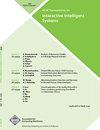Visual Analytics of Neuron Vulnerability to Adversarial Attacks on Convolutional Neural Networks
IF 4.8
4区 计算机科学
Q2 COMPUTER SCIENCE, ARTIFICIAL INTELLIGENCE
引用次数: 2
Abstract
Adversarial attacks on a convolutional neural network (CNN)—injecting human-imperceptible perturbations into an input image—could fool a high-performance CNN into making incorrect predictions. The success of adversarial attacks raises serious concerns about the robustness of CNNs, and prevents them from being used in safety-critical applications, such as medical diagnosis and autonomous driving. Our work introduces a visual analytics approach to understanding adversarial attacks by answering two questions: (1) which neurons are more vulnerable to attacks and (2) which image features do these vulnerable neurons capture during the prediction? For the first question, we introduce multiple perturbation-based measures to break down the attacking magnitude into individual CNN neurons and rank the neurons by their vulnerability levels. For the second, we identify image features (e.g., cat ears) that highly stimulate a user-selected neuron to augment and validate the neuron’s responsibility. Furthermore, we support an interactive exploration of a large number of neurons by aiding with hierarchical clustering based on the neurons’ roles in the prediction. To this end, a visual analytics system is designed to incorporate visual reasoning for interpreting adversarial attacks. We validate the effectiveness of our system through multiple case studies as well as feedback from domain experts.卷积神经网络对抗性攻击下神经元脆弱性的可视化分析
对卷积神经网络(CNN)的对抗性攻击——在输入图像中注入人类难以察觉的扰动——可能会欺骗高性能的CNN做出错误的预测。对抗性攻击的成功引发了人们对cnn鲁棒性的严重担忧,并阻碍了它们在医疗诊断和自动驾驶等安全关键应用中的应用。我们的工作引入了一种视觉分析方法,通过回答两个问题来理解对抗性攻击:(1)哪些神经元更容易受到攻击;(2)这些脆弱的神经元在预测过程中捕捉到哪些图像特征?对于第一个问题,我们引入了多个基于微扰的度量,将攻击幅度分解为单个CNN神经元,并根据其脆弱性等级对神经元进行排名。其次,我们识别高度刺激用户选择的神经元的图像特征(例如,猫耳),以增强和验证神经元的职责。此外,我们通过基于神经元在预测中的作用的分层聚类来支持对大量神经元的交互式探索。为此,设计了一个视觉分析系统来结合视觉推理来解释对抗性攻击。我们通过多个案例研究以及来自领域专家的反馈来验证我们系统的有效性。
本文章由计算机程序翻译,如有差异,请以英文原文为准。
求助全文
约1分钟内获得全文
求助全文
来源期刊

ACM Transactions on Interactive Intelligent Systems
Computer Science-Human-Computer Interaction
CiteScore
7.80
自引率
2.90%
发文量
38
期刊介绍:
The ACM Transactions on Interactive Intelligent Systems (TiiS) publishes papers on research concerning the design, realization, or evaluation of interactive systems that incorporate some form of machine intelligence. TIIS articles come from a wide range of research areas and communities. An article can take any of several complementary views of interactive intelligent systems, focusing on:
the intelligent technology,
the interaction of users with the system, or
both aspects at once.
 求助内容:
求助内容: 应助结果提醒方式:
应助结果提醒方式:


